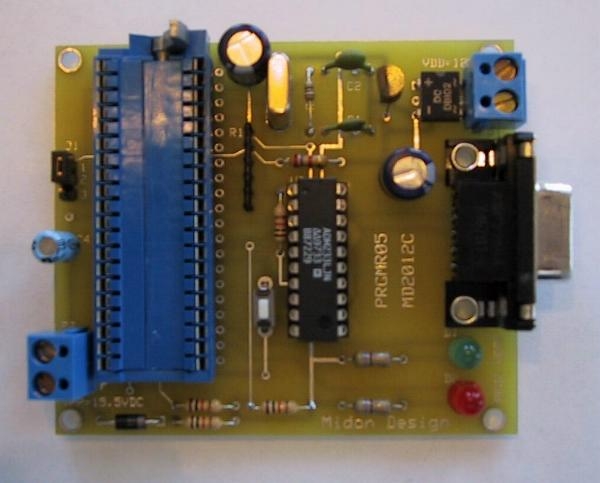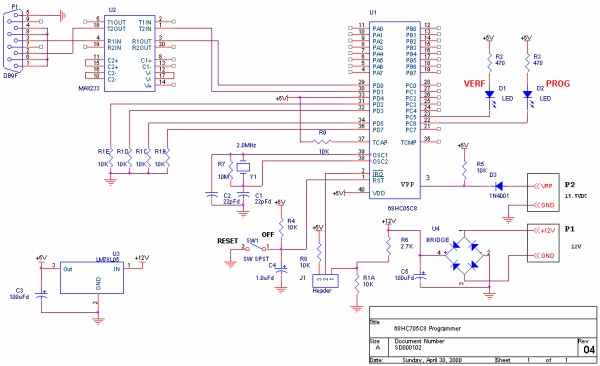Introduction
This programmer is used for programming the Motorola 68HC705C8 (or C8A).
The 68HC705C8 has the following attributes;
- 8K bytes of internal EPROM
- 304 bytes of internal RAM
- 24 user-definable input/output ports
- 7 Input only ports
- Serial Control Interface (SCI)
- Serial Peripheral Interface (SPI)
- 16 bit capture/compare timer system
- Watch Dog timer

The PC software used to program the micro-controllers was written and developed by Gil Shultz.
As you can see from the schematic diagram in Figure 2, this is a very simple circuit built around Motorola’s 68HC705C8 8 bit micro-controller.
The SCI is connected to a MAX233 serial interface driver from Maxim. This five-volt only device converts the TTL level serial communications to standard RS232 levels through the use of built-in voltage converters. No external capacitors or additional power supplies are required to obtain the ± 12 volts required for standard RS232 levels.
A simple power supply, consisting of U3 and C5, converts 12 volt DC to the 5 volts required for the circuit. A LM78L05 version of voltage regulator was used due to the low power consumption (less than 32mA, worst-case) of the circuit. The programming voltage, 15.5VDC ± 0.5V, is connected when requested to connector P2.
Two LED’s are available to provide a visual state of programming.
Construction
Standard construction techniques may be used for this circuit and a printed circuit board is available if desired. The prototype was point-to-point wired on a Radio Shack prototype PCB (part # 276-168B).
If building the Programmer from the PCB, refer to Figure 3 for component placement. Begin by inserting IC sockets (highly recommended). Follow this with the insertion of all passive components. I like to proceed by inserting all resistors, then all capacitors. Watch the polarity of the electrolytic capacitors. The positive lead of the electrolytic capacitors is the square pad for that component.

Next, insert voltage regulator U3. At this time, you should also insert connectors P1 and P2. Once that is done, put down the soldering iron and get out a suitable power supply. Connect the power supply to the terminals of P1, being careful to connect the proper polarity to the correct terminal. Power up and then measure voltages between pins 40 and 20 of IC U1. Pin 40 should be +5 volts while pin 20 is ground. If you are wiring this circuit on your own board, then check polarity on the other IC socket as well. Table 2 shows the voltages required on each IC.
For more detail: Build a Programmer for the 68HC705C8 MicroController

